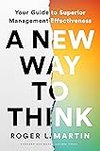
A New Way to Think

thinking from first principles, as we sometimes must do when we encounter an unprecedented situation for which we have no model, is arduous, time-consuming, and downright scary.
Roger L. Martin • A New Way to Think
The previous exercise typically overshoots, and the list of conditions crosses the line between “must have” and “nice to have.” After finishing the list of conditions, the group should take a break and then review the items, asking, “If every condition but this one held true, would you eliminate the possibility or still view it as viable?” If the
... See moreRoger L. Martin • A New Way to Think
the possibilities-based approach forces managers to move away from asking “What is the right answer?” and concentrate instead on “What are the right questions? What specifically must we know in order to make a good decision?”
Roger L. Martin • A New Way to Think
When each member of the group has had a chance to add conditions to the list, the facilitator should read the list aloud and ask the group, “If all these conditions were true, would you advocate for and support this choice?” If everyone says yes, it’s time to move to the next step. If any members say no, they must be asked, “What additional
... See moreRoger L. Martin • A New Way to Think
In this chapter I’ll lay out a seven-step approach to strategy-making anchored in the structured formulation of a set of well-articulated hypotheses—or strategic possibilities—for strategists to choose between.
Roger L. Martin • A New Way to Think
It’s usually not a good idea to have the most senior person serve as the leader; she will have a difficult time convincing the others that she is not playing her usual role as boss. Instead, choose a respected lower-level insider who is not perceived as having a strong point of view on which course should be chosen. Or tap an outside facilitator
... See moreRoger L. Martin • A New Way to Think
For managers, the implications of this are clear: the only sure way to increase shareholder value is to raise expectations about the future performance of the company from their current level. Unfortunately, executives simply can’t do that indefinitely.
Roger L. Martin • A New Way to Think
If the corporation can bring to bear substantial advantages to either an existing portfolio business or a business not currently in the portfolio, either of these should be taken as a signal for investing to expand the portfolio in that direction.
Roger L. Martin • A New Way to Think
For product development, you should start with an inventory of your adjacent possible.
Competition. The classic model holds that corporations compete, and a central job of the corporate level is to organize and control the levels below it. A more effective model holds that competition happens at the front line where real customers are served, and that the job of every corporate level above the frontline level is to help the level
... See more